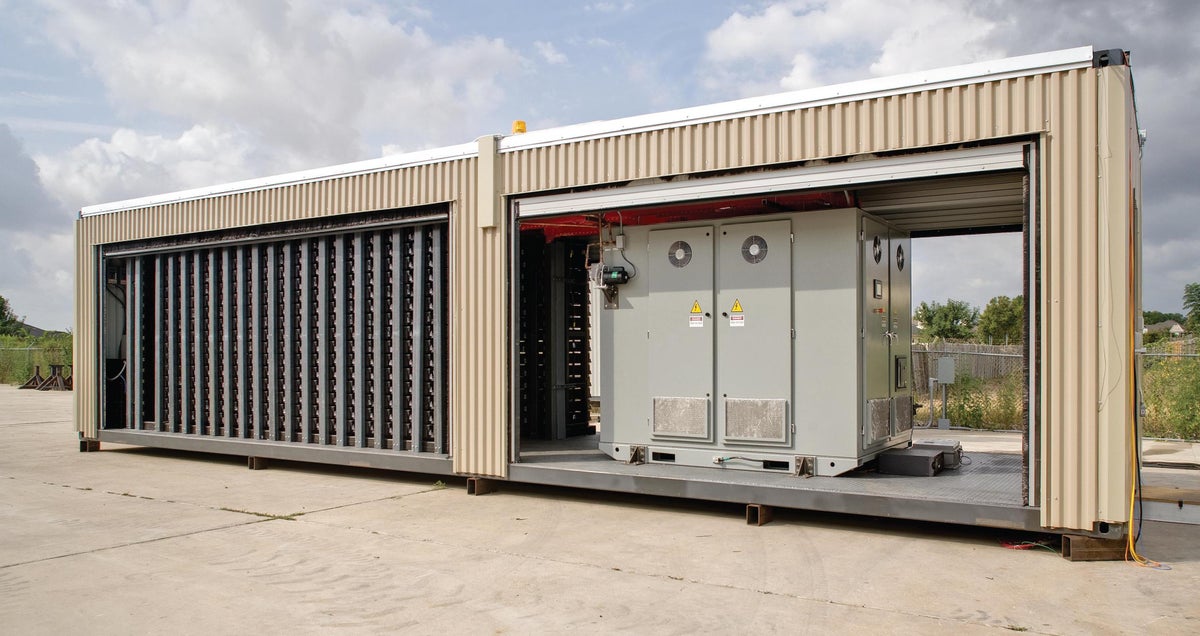Exploring Chemical Methods to Overcome Renewable Energy’s Biggest Challenge

Renewable energy storage unit
August 13, 2024 | By Dave DeFusco
Since 2022, Megan Jackson, an assistant professor of chemistry, has focused on tackling one of the most pressing issues in the transition to renewable energy: storage. With a team of dedicated graduate and undergraduate students, Jackson’s lab is making significant strides in developing advanced electrode materials that can efficiently store energy generated from solar and wind sources.

Renewable energy, such as solar and wind power, is key to a sustainable future, but these sources come with a significant challenge: intermittency. The sun doesn’t always shine and the wind doesn’t always blow, making it crucial to find effective ways to store this energy for use when generation is not possible. Jackson’s research addresses this problem through ingenious chemical methods.
In the paper, Controlling Nucleation Sites for Metal Oxide Film Growth on Glassy Carbon via Electrochemical Preoxidation, published in Applied Materials and Interfaces, Jackson’s lab proposed a new method to improve the coating of carbon-based electrode materials, such as glassy carbon, with metal oxides. It holds significant potential for various electrochemical applications, including protection against corrosion, creation of charge storage materials and enhancement of batteries and supercapacitors.
“Our research discovered that using electricity to pre-treat glassy carbon surfaces makes it easy to add metal oxide layers that protect the surface. This method can be adjusted to get different levels of protection,” said Devon Leimkuhl, lead author of the paper with Carrie Donley, both Ph.D. students in chemistry. “This improvement can make electrochemical devices work better and last longer, which is an important advancement in materials science.”
Jackson’s team studies two primary chemistry-based methods for energy storage: Storing energy in chemical bonds and large-scale battery storage. The former involves converting electricity generated by renewable sources into fuel, which can later be converted back into electricity. This process requires efficient electrodes to act as catalysts, minimizing the energy needed for the conversion. And while batteries are a familiar technology for everyday devices, Jackson’s research aims to scale up battery technology to store energy at the grid level, providing a reliable storage solution for solar and wind energy.
Designing effective electrode materials is complex due to the need to understand and manipulate properties at the molecular level. Jackson’s lab employs a combination of systematic design and advanced techniques, such as scanning electrochemical cell microscopy (SECCM) to study and improve these materials. By probing electrodes at the nanoscale, they can identify which parts contribute to high catalytic activity, paving the way for more efficient energy storage solutions.
The research has far-reaching implications, from water splitting to produce hydrogen fuel, which is a clean energy source, to CO2 reduction, which can simultaneously address carbon emissions and produce useful chemicals. These applications depend on the ability to design catalysts that lower the energy barriers of these reactions.
Jackson attributes much of the lab’s success to the supportive and collaborative environment at UNC. She said the university’s excellent research facilities and the opportunity to work with experts from various fields provide a rich intellectual environment that fosters innovation.
“The ultimate goal is to achieve a level of understanding that allows for the systematic design of new electrode materials, leading to more efficient and effective renewable energy systems,” said Jackson, the senior author of the paper. “Our work at UNC is paving the way for a more sustainable and efficient energy future.”

